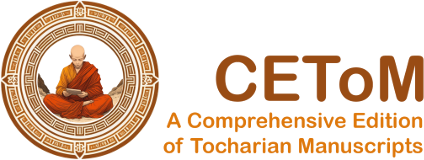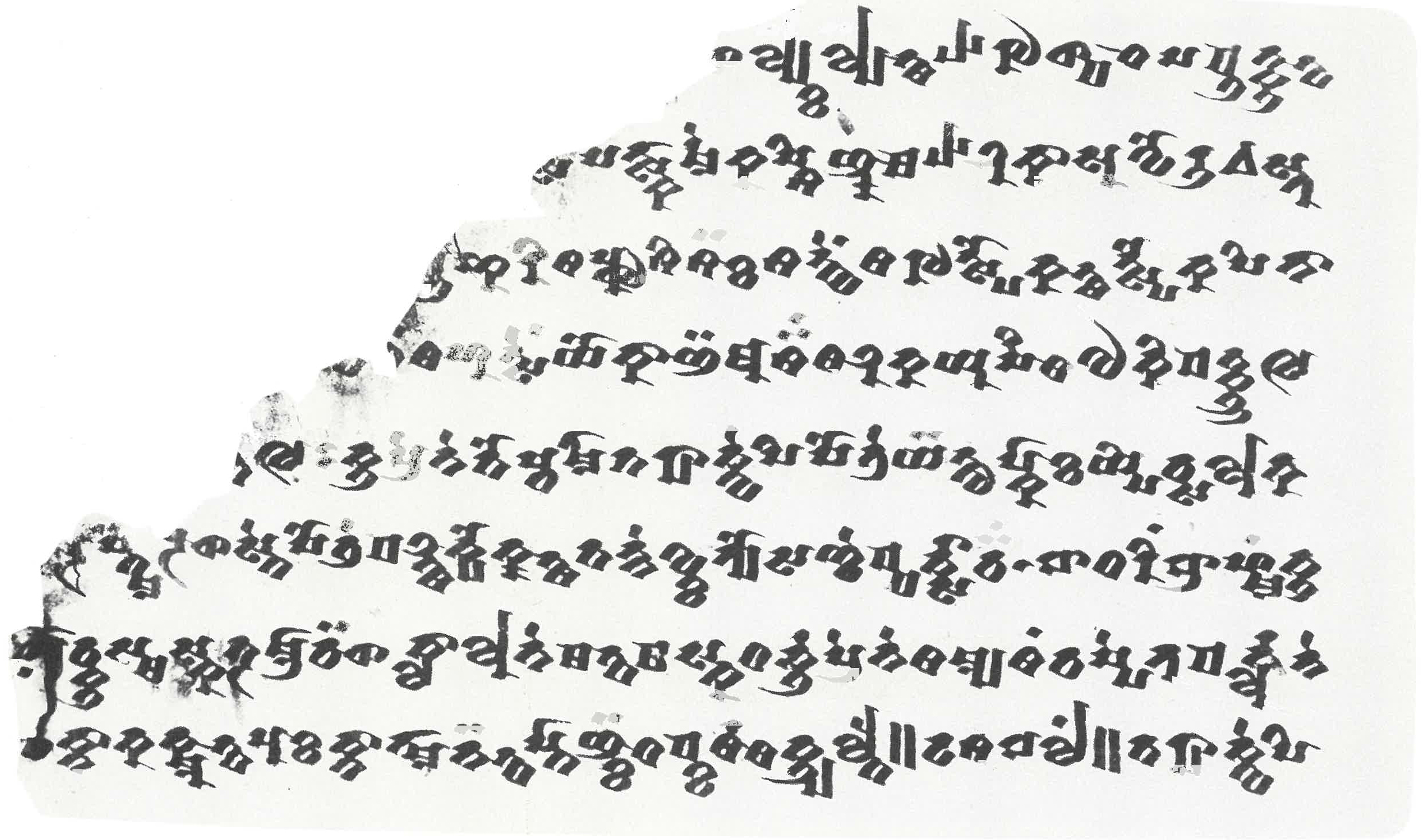Work in progress
YQ II.5
| Known as: | YQ II.5; YQ 1.14 |
|---|
| Cite this page as: | "YQ II.5". In A Comprehensive Edition of Tocharian Manuscripts (CEToM). Created and maintained by Melanie Malzahn, Martin Braun, Hannes A. Fellner, and Bernhard Koller. https://cetom.univie.ac.at/?m-yqii5 (accessed 03 Jul. 2025). |
|---|
Provenience |
| Main find spot: | Qigexing |
|---|
| Collection: | Xinjiang Museum (Ürümchi) |
|---|
Language and Script |
| Language: | TA |
|---|
| Script: | classical |
|---|
Text contents |
| Title of the work: | Maitreyasamiti-Nāṭaka |
|---|
| Passage: | Act 2.5 |
|---|
| Text genre: | Literary |
|---|
| Text subgenre: | Drama |
|---|
| Verse/Prose: | prose; verse |
|---|
| Meter: | 4343 (4x) |
|---|
Object |
| Manuscript: | Yanqi |
|---|
| Material: |
ink
on paper |
|---|
| Form: | Poṭhī |
|---|
| Number of lines: | 8 |
|---|
Images
Transliteration
| a1 | /// ¯s̝ lykä lyä¯ ¯ts 10 5 s̝pa¯ ¯t pa pla tku¯ ¯nt |
|---|
| a2 | /// ·s· pa tskā rme ka pśi ññu m 10 9 kā su wo ru e snu |
|---|
| a3 | /// [ā] ṅka ri 20 4 śi śä¯ ¯k śa nweṃ 20 5 tspo ka¯ ¯ts tspo ka ṣi nā |
|---|
| a4 | /// [w]· [ś]·ṃ 20 8 tseṃ yo kā¯ ¯ñä a śäṃ 20 9 ka yu rṣi¯ ¯s o ki pa tkru 30 |
|---|
| a5 | /// [naṃ] 30 2 ku pre ne to ṣca mī ta ryā kwe pi ṣo tre yä ntu pkā¯ ¯k ypi csa lu ka |
|---|
| a6 | /// [pra] ṣtm[o] ra¯ ¯s̝ sne ṣo tre pa ltsa kyo kka¯ ¯ts ta nne wka nyo sa ñce ppa rksā cäṃ • bā dha riṃ brā hmaṃ ku |
|---|
| a7 | /// [mr]ā cku sma ska tra mrā cä¯ ¯s̝ klā lu ne ma¯ ¯nt ma ska ta rku pre ne sa mya saṃ ca ṣpe nu pa rklu ne |
|---|
| a8 | /// [w]· knā ka kmu¯ ¯nt pu¯ ¯k knā nmā nä¯ ¯nt ptā ñkä¯ ¯t pka rsa¯ ¯s kuya lte || da śa ba laṃ || ta ryā kwe pi |
|---|
| b1 | /// [ñc]ä ka pśi ññaṃ pu kka rsnā¯ ¯nt śkaṃ knā nmu ne : kra sa s̝pa lskaṃ pa lsko¯ ¯nt pu¯ ¯k wä tkā ṣwä |
|---|
| b2 | /// [ñä] kta sna peṃ śśi : 1 || ku sne ya sṣo me to saṃ pa rklu ne ytu pa rkcä¯ ¯r tma¯ ¯s̝ wā ka rṣo me ṣñi |
|---|
| b3 | /// [ve] da vyā ka ra ṇa • lo kā ya na • ho ra ga ṇi ta • na kṣa ca ri ta pu rā ṇä kupā raṃ mā |
|---|
| b4 | /// [kr]ā sa rki ppa rksā cäṃ • kupre ne sa mpe nu sne ta ṅklu ne wä tkā¯ ¯lts wä tkā s̝s̝a¯ ¯m |
|---|
| b5 | /// – [ka] lpā laṃ pu tti śpa rṣi näṃ ñe mi ṣiṃ pra ṅkā ka kmu ṣya sse wā¯ ¯ñä : |
|---|
| b6 | /// yo mnā¯ ¯cä o ṅkra ci : ṣa kka¯ ¯ts śkaṃ ñi tma¯ ¯s̝ pā¯ ¯k plo¯ ¯s ymā |
|---|
| b7 | /// [a] ji teṃ pra cra ṣṣa ci śä kpa ñpi ma na rkā sa śśä¯ ¯l bā dha |
|---|
| b8 | /// r[k]ā sā pe ypa māṃ bā dha ri sprā mne wa ṣtwä s̝la¯ ¯cä |
|---|
Transcription
Translation
| a1+ | (hairs turned toward the right [13];) (exceedingly) fine his skin [15]; seven prominent [places] ([16]; sculptured as it were between his shoulders [17]; the upper part of his body ... [18]); large and straight his body [19]; with well-shaped shoulders ([20]; forty teeth [21];) /// [23]; very white his canines [24]; lion-jaws [25]; (having obtained the distinction) of all kinds of tastes (26); /// a voice like that of (Brahmā) [28]; blue eyes [29]; eyelashes like those of a [yak] bull [30]; (on his head an uṣṇīṣa [31]; a white tuft of hair) between (his eyebrows) [32]; |
|---|
| a5+ | If all these thirty-two signs (are) complete in their entirety on his body, (then you), standing (in front of him), without a hint, in your minds only ask him question[s] as follows: |
|---|
| a6+ | About Bādhari the Brahmin, what (is his descent? |
|---|
| a7 | How old is he? How many brahmin youths does he teach the Śāstras?) What is the ‘top’? What is ‘falling from the top’? |
|---|
| a7+ | If this one (is able to answer) these questions asked also by you (immediately and without hesitation, then you are indeed) to recognize him surely as the Tathāgata and the all-knowing Buddha-god. |
|---|
| a8 | Why that? || In the Daśabala [tune] || |
|---|
| a8+ | (A being endowed with the) thirty-two (marks clearly and in their entirety present), /// in heart and body and the knower of all knowledge, will know in his mind all that has been thought |
|---|
| b1+ | and will answer firmly (without ambiguity, |
|---|
| b2 | 1. || |
|---|
| b2 | this one) ... of gods and mortals. |
|---|
| b2+ | When some of you have asked the questions mentioned, then some others on their part, each (according to his educational training, in connection with skills as) ... Veda, grammar [Vyākaraṇa], materialism [Lokāyatana], horoscope and astrology [Horāgaṇita], dancing and acting [Nāṭyacarita], legends [Purāṇa], deep and difficult (questions, quietly kept in your minds only,) ask him one after the other. |
|---|
| b5+ | If this one also gives his answers to you without hesitation and firmly, ... you, my sons, having come to the jewel-island of the (difficult)-to-attain Buddha rank, ... (when) you reach immortal (bliss), be sure and send part of it quickly (back) to me! |
|---|
| b7+ | ... with fifteen brahmin youths beginning with his brother Ajita, ... (of) Bādhari ... by the brahmin youths, making his obeisance, he left the abode of Bādhari the Brahmin |
|---|
Other
| a5+ | If all these thirty-two signs are complete in their entirety on his body, then, standing in front of him, without a hint, and in your minds only, you [pl.] must ask him question[s] as follows: … (cf 91) (Peyrot 2013b: 645) |
|---|
| a7+ | If he also understands your [pl.] questioning immediately and without hesitation, then you [pl.] are indeed to recognise him surely as the (Tat)hāgata and the all-knowing Buddha. (cf 91) (Peyrot 2013b: 253) |
|---|
| b1 | He will know in his mind all that has been thought and will answer firmly without ambiguity (…). (cf 91) (Peyrot 2013b: 628) |
|---|
| b2+ | When [lit. who] some of you [pl.] have asked the questions mentioned, then some [others] on their part, each according to his educational training, in connection with skills as …, must ask him, one after the other, deep and difficult questions, quietly kept in your minds only. (cf 91, 93) (Peyrot 2013b: 645) |
|---|
| b4 | If he also answers you [pl.] without hesitation and firmly, … (cf 93) (Peyrot 2013b: 646) |
|---|
| b6 | When you [pl.] reach immortal (bliss), surely send also part of it quickly (back) to me! (cf 93) (Peyrot 2013b: 254) |
|---|
Commentary
Linguistic commentary
| * | The commentary is adapted from Ji et al. 1998: 94. |
|---|
| n1 | The final ṣ\ after the gap is probably to be restored as (lyutār mema)ṣ\. |
|---|
| n4 | For tspokats tspokaṣinās with dittography read tspoka-tspokaṣinās, cf. rasa-rasa- in the Skt. compound. |
|---|
| n12 | wākär is identified as a 3rd pl. pret. in Gr., p. 468 and TEB II: 139. This does not fit the context. Therefore, the form seems best interpreted as an adverb. |
|---|
| n16 | pe may be miswritten for paṃ, a particle which occurs frequently close to the verb ya-/yām- ‘to do’, cf. TEB II: 113. |
|---|
Parallel texts
Remarks
Philological commentary
| n2 | Cf. A 213: a3. The beginning of the Yanqi leaf corresponds to MaitrHami 2, 5 a27f and its last line to 6 b7-9 (for the Uy. references, cf. Ji et al. 1998: 18). |
|---|
| n3 | Cf. A 213: a4, YQ II.10: b1 and A 213: a5. |
|---|
| n5 | Cf. A 213: a5, end of the fragment; A 213: a6 and A 217: b2. |
|---|
| n6 | Cf. A 213: a6, end of the fragment. |
|---|
| n7 | Cf. A 213: a7. |
|---|
| n8 | Cf. A 213: b1. |
|---|
| n9 | Cf. A 213: b2; see MaitrHami 2, 6 a4-5. |
|---|
| n10 | Cf. A 213: b3. For the next akṣara, the published photograph (plate 27 in Ji et al. 1998: 332) allows both wä- and waṃ- for a reading. daśabalaṃ is a stanza of 4 x 14 (7/7) syllables. |
|---|
| n11 | For the restored first part of this line, cf. A 213: b4, end of the fragment. |
|---|
| n13 | For the restored first part of this line, cf. A 213: b5. |
|---|
| n14 | For the restored first part of this line, cf. A 213: b6; see MaitrHami 2, 6 a18-23. |
|---|
| n15 | For the restored first part of this line, cf. A 213: b7. |
|---|
References
Edition
Ji et al. 1998
Translations
Peyrot 2013b: a5 a6 (645), a7 a8 (253), b1 (628), b2 b3 b4 (645), b4 (646), b6 (254)
Bibliography
Ji et al. 1998
Ji, Xianlin, Werner Winter, and Georges-Jean Pinault. 1998. Fragments of the Tocharian A Maitreyasamiti-Nāṭaka of the Xinjiang Museum, China. Transliterated, translated and annotated by Ji Xianlin in collaboration with Werner Winter, Georges-Jean Pinault. TLSM 113. Berlin/New York: de Gruyter.
Peyrot 2013b
Peyrot, Michaël. 2013b. The Tocharian subjunctive. A study in syntax and verbal stem formation. Vol. 8. Brill’s Studies in Indo-European Languages & Linguistics. Leiden/Boston: Brill.
Pinault 1999
Pinault, Georges-Jean. 1999. “Restitution du Maitreyasamiti-Nāṭaka en tokharien A: Bilan provisoire et recherches complémentaires sur l’acte XXVI.” Tocharian and Indo-European Studies 8: 189–240.
TEB II
Thomas, Werner, and Wolfgang Krause. 1964. Tocharisches Elementarbuch, Band II. Texte und Glossar. Heidelberg: Winter.




